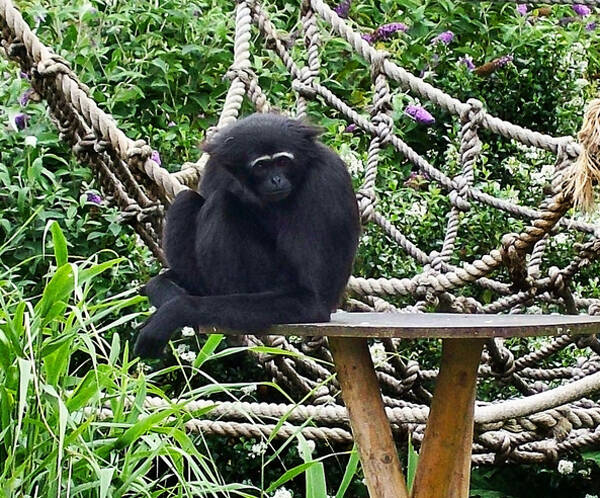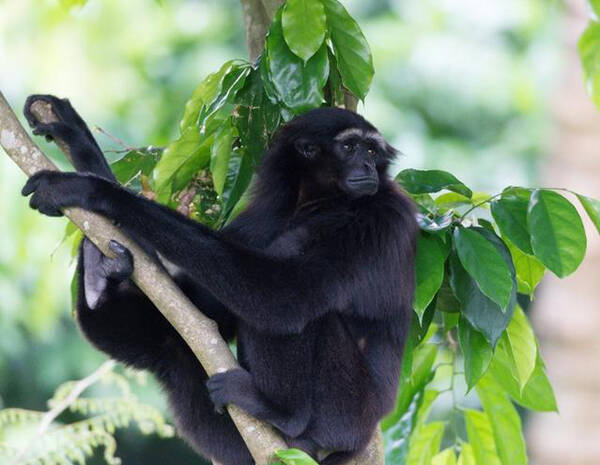Hylobates agilis
IUCN
LCBasic Information
Scientific classification
- name:Hylobates agilis
- Scientific Name:Hylobates agilis,Agile Gibbon,Agile Gibbon
- Outline:Primates
- Family:G.family genus
Vital signs
- length:50-76cm
- Weight:4-6kg
- lifetime:25-44years
Feature
Has extremely long arms and fingers, and no tail
Distribution and Habitat
Distributed in Indonesia (Kalimantan, Sumatra), Malaysia (Malaysian Peninsula), Thailand.
It mainly lives in tropical rainforests in South Asia and Southeast Asia, generally at an altitude of 1000-2000 meters.
Appearance
The black-handed gibbon is a small ape species. The average weight of females is 5.4 kg and that of males is 5.8 kg. The hair is of various colors, including black, brown, camel and reddish brown. Both sexes have white eyebrows. Males have white bristles around their cheeks, which are not present in females, which can be clearly distinguished. There is no tail. Like other gibbons, it has extremely long arms and fingers. This provides adaptive assistance when swinging between trees.
The legs are short, the palms are longer than the soles of the feet, and the finger joints are long; the body is slender, the shoulders are broad and the hips are narrow; there are long canine teeth. There are calluses on the hips, no tail and cheek pouches. There is a sound bag in the throat, and it is good at singing.
Details
The black-handed gibbon (scientific name: Hylobates agilis) is also known as Agile Gibbon in English. It has two subspecies.

Black-handed gibbons usually form a family of 4, including an adult male and an adult female, and the rest are semi-adult and young gibbons, with an adult male as the leader. Gibbons have a relatively long maturity period, and family relationships are not only stable, but also harmonious and friendly. Family members are generally very harmonious, love each other, and defend each other.
The habits of the black-handed gibbon are similar to those of the black gibbon. They live a family life with male and female spouses and are territorial. The territory of each group is about 54 hectares, but they only forage within 1.5 square kilometers in a day. During the day, they use their arms to climb branches and swing and jump on trees 20-30 meters high in the forest, using both their front and back limbs at high speed. Due to the high-altitude characteristics of this movement, they often change the direction of their chest and arms. Long-term evolutionary adaptation has made the sides of their shoulders flat, unlike monkeys, which are relatively wide. Their elbows are longer and can rotate 360 degrees in all directions. They can move forward and backward quickly, and their feet only play the role of assisting pedaling. They have keen hearing and smell, are timid, and are afraid of cold.
The calls of the black-handed gibbons are the main form of communication among the group members. Every morning, males and females sing in chorus, with ups and downs, sad and low, or intermittent sounds similar to blowing bubbles. The male's call is sandwiched between the female's call, and at the end of the call, a tail sound is added. Tactile communication is also important between parents and their offspring. Tactile communication involves grooming, mating, playing, and sometimes aggressive behavior. In addition to vocal and tactile communication, these animals also use facial expressions, gestures and body postures to communicate with their own species.
Black-handed gibbons consume a lot of fruit. Like other gibbons, these animals are mainly frugivores. They also eat a variety of other foods, including leaves, flowers and insects. Due to their high activity level, it is necessary to consume calorie-rich foods, and fruits have a high calorie content.

Black-handed gibbons reach sexual maturity at the age of 8, and there is no strict breeding season. The gestation period of females is about 7-8 months. After mating and conception, they still move with the group. After 3-4 months, their abdomens bulge slightly. As the fetus grows, their abdomens gradually increase, and their daily actions become more cautious, but they still stay with the group until giving birth. Births usually occur in autumn and early winter, with only one baby born per litter. The newborn baby is light yellow in color and weighs 110-170 grams. It gradually turns black or brownish black after 4-5 months of age. It is weaned after 6 months and can live completely independently at 8 months, but it still does not leave the group until it is about 6 years old and close to sexual maturity. It slowly leaves the group and lives independently. It reaches sexual maturity at 7-8 years old and looks for a mate. The lifespan is about 25 years. It is reported that the lifespan of artificially raised black-handed gibbons can reach 44 years. A couple can give birth to 5-6 babies in their lifetime, with an interval of about 40 months between each birth.
In 2004, a population assessment of black-handed gibbons was conducted in Bukit Barisan Selatan National Park on the island of Sumatra, Indonesia, and the calculated data was 4,479 gibbons (CV=30%). In peninsular Malaysia, the population is found in Belum and Ulu Muda. In Thailand, the population may be several thousand individuals, distributed in about three forest areas. The species' range density is estimated to be 1.4-2.8 individuals/km2 (2004), and 6-11.4 individuals/km2 (2002), and in peninsular Malaysia to be 5.5-18.9 individuals (2-5 groups)/km2 (1979). The most recent survey in southern Thailand showed a density of 2 groups/km2, which is part of the Harabala Wildlife Sanctuary.
The black-handed gibbon is not an important economic resource for humans. These animals are sometimes used as human food, and they are illegally captured for the pet trade. Poaching is one of the threats, and those who are caught in the mishandling of animal transportation often die. Illegal poaching for meat and pet trade is a contributing factor to the decline of the species. Their habitat is rapidly decreasing due to large-scale logging. Habitat loss is the main threat to the gibbon species due to logging and agricultural needs.
Listed in the 2008 Red List of Threatened Species of the World Conservation Union (IUCN) ver 3.1 - Endangered (EN).
Protect wild animals and eliminate game.
Maintaining ecological balance is everyone's responsibility!








